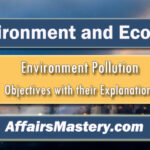Set 1 | Important Ecology MCQs
Important Ecology MCQs. Ecology plays a crucial role within the broader field of environment and ecology. It serves as a foundational concept for achieving success in competitive exams such as Civil Services, State exams, SSC, Railways, Banking, and more. Mastering these subjects offers a unique advantage, allowing you to gain invaluable insights into the country’s environmental legacy. With a focus on Environment, Biodiversity, and Ecology, this knowledge not only sharpens your competitive edge but also equips you to excel in these challenging exams.
| MCQs on Ecology – Objective Questions and Answers |

Q1. ‘Ecology’ is the study of the relationship between– (U.P.R.O./A.R.O. (Pre) 2014)
[A] Organism and environment
[B] Man and forest
[C] Soil and water
[D] Husband and wife
View Explanation
Correct Answer is A.
- The term ‘ecology‘ comes from the Greek word ‘Oikos,’ meaning house or environment. Ecology involves studying the interactions between organisms and their environment, including their relationships with non-living components.
- German scientist Ernst Haeckel (1834-1919) coined the term ‘ecology’ (‘Oekologie’) and defined it as the study of an organism’s relationship with its environment.
- Today, ecology has expanded to cover a broader scope, encompassing not only plants, animals, and climate but also humans and their physical surroundings.
Q2. The term Ecosystem was proposed by – (Uttarakhand P.C.S. (Pre) 2005)
[A] G. Tailor
[B] E. Hartigan
[C] D.R. Stoddart
[D] Tansley
View Explanation
Correct Answer is D.
- The term ‘ecosystem‘ was first introduced by A. G. Tansley in 1935, who defined it as “a particular category of physical systems, consisting of organisms and inorganic components in a relatively stable equilibrium, open and of various sizes and kinds.”
- An ecosystem is a community of living organisms (such as plants, animals, and microbes) interacting with the nonliving elements of their environment (such as air, water, minerals, and soil) as a system.
- These biotic and abiotic components are interconnected through nutrient cycles and energy flows. Ecosystems are defined by the interactions between organisms and their environment and can range in size from a drop of water to an ocean. The Earth itself is considered a vast ecosystem.
Q3. Which of the following is not true about the eco- system? (U.P.P.C.S. (Mains) 2014)
[A] It represents all living organisms and the physical environment in any given space-time unit.
[B] It is a functional unit.
[C] It has own productivity.
[D] It is a closed-system.
View Explanation
Correct Answer is D.
An ecosystem is a community of living organisms interacting with the non-living elements of their environment (such as air, water, and mineral soil), functioning together as a system. Key features of ecology include:
- Ecosystems are typically open systems with a continuous yet variable exchange of materials and energy.
- An ecosystem represents the integration of all interacting organisms and their environment.
- It is a fundamental functional unit without defined boundaries.
- Ecosystems consist of both biotic and abiotic components that interact with each other.
- The functional unit of an ecosystem is capable of energy transformation, circulation, and accumulation.
Various types of ecosystems exist in different regions.
Q4. Which of the following is not correct about the ecosystem? (U.P.P.C.S. (Pre) (Re. Exam) 2015)
[A] It comprises both, abiotic and biotic components
[B] It has its productivity.
[C] It is a closed system.
[D] It is a natural resource system.
View Explanation
Correct Answer is C.
- The statement “An ecosystem is a closed system” is incorrect. Ecosystems are typically open systems, meaning they exchange energy and matter with their surroundings, allowing for the influx and loss of materials and energy.
Q5. Which four components constitute an ecosystem? (Jharkhand P.C.S. (Mains) 2016)
[A] Water, Carbon, Oxygen, Sulphur
[B] Soil, Temperature, Humidity, Rainfall
[C] Abiotic materials, Producers, Consumers, Decomposers
[D] Herbivores, Carnivores, Bacteria, Parasites
View Explanation
Correct Answer is C.
- The four basic components of an ecosystem include abiotic materials, producers, consumers, and decomposers (or reducers). Producers, consumers, and decomposers fall under the broader category of “biotic materials” or “biotic factors.”
- These biotic factors represent the living components of an ecosystem, while abiotic materials refer to the non-living elements like air, water, and minerals.
View Infographic of four components of Ecosystem

Q6. Which one of the following is the best description of the term ‘ecosystem’? (I.A.S. (Pre) 2015)
[A] A community of organisms interacting with one another.
[B] That part of the Earth which is inhabited by living organisms.
[C] A community of organisms together with the environment in which they live
[D] Flora and fauna of a geographical area.
View Explanation
Correct Answer is C.
- All living organisms, along with the non-living components of their environment, come together to create the ecosystem of a particular place.
- This includes factors such as air, water, soil, and climate, which interact with the organisms to sustain life. Ecology, as a scientific discipline, explores these interactions, examining how organisms depend on and influence both their living and non-living surroundings.
- It looks at the relationships between species, their adaptations to environmental changes, and the complex dynamics that maintain balance within ecosystems. Thus, ecology fundamentally addresses the interconnectedness of life and its environment.
Q7. Which of the following is an artificial ecosystem ? (Jharkhand P.C.S. (Pre) 2013)
[A] Ponds
[B] Field
[C] Forest
[D] None of these
View Explanation
Correct Answer is B.
- Fields and gardens are examples of artificial ecosystems, as they are created and maintained by human intervention.
- In contrast, forests, ponds, and lakes are natural ecosystems, where the balance between living organisms and their environment occurs without direct human management.
- These natural ecosystems function independently and maintain their equilibrium through natural processes.
Q8. Which of the following is an artificial ecosystem? (U.P.P.C.S. (Pre) 2016)
[A] Rice field
[B] Forest
[C] Grassland
[D] Lake
View Explanation
Correct Answer is A.
- An artificial ecosystem meets all the requirements of a natural ecosystem but is created and controlled by humans. Examples of artificial ecosystems include orchards, farmlands, gardens, and human-made reservoirs.
- Ecosystems can generally be classified into two broad categories: aquatic and terrestrial. Terrestrial ecosystems include grasslands, forests, and deserts, while aquatic ecosystems encompass lakes, rivers, and oceans.
- Notably, agriculture, as part of the human ecosystem, has played a crucial role in the survival and development of human society.
Q9. The number of organisms that can be supported by the environment in a given area is known as: (Uttarakhand P.C.S. (Pre) 2012)
[A] Population
[B] Carrying Capacity
[C] Pyramid of number or biomass
[D] None of the above
View Explanation
Correct Answer is B.
- The maximum population size that an ecosystem can sustainably support is known as its carrying capacity. This term refers to the number of organisms that an ecosystem can maintain over time without degrading the environment.
Q10. Which one of the following terms describes not only the physical space occupied by an organism but also its functional role in the community of organisms? (I.A.S. (Pre) 2013)
[A] Ecotone
[B] Ecological niche
[C] Habitat
[D] Home range
View Explanation
Correct Answer is B.
- An ecological niche characterizes a species’ position within an ecosystem by encompassing both its habitat requirements and its functional role. This includes the species’ interactions with other organisms, its use of resources, and its contributions to energy flow and nutrient cycling within the ecosystem.






